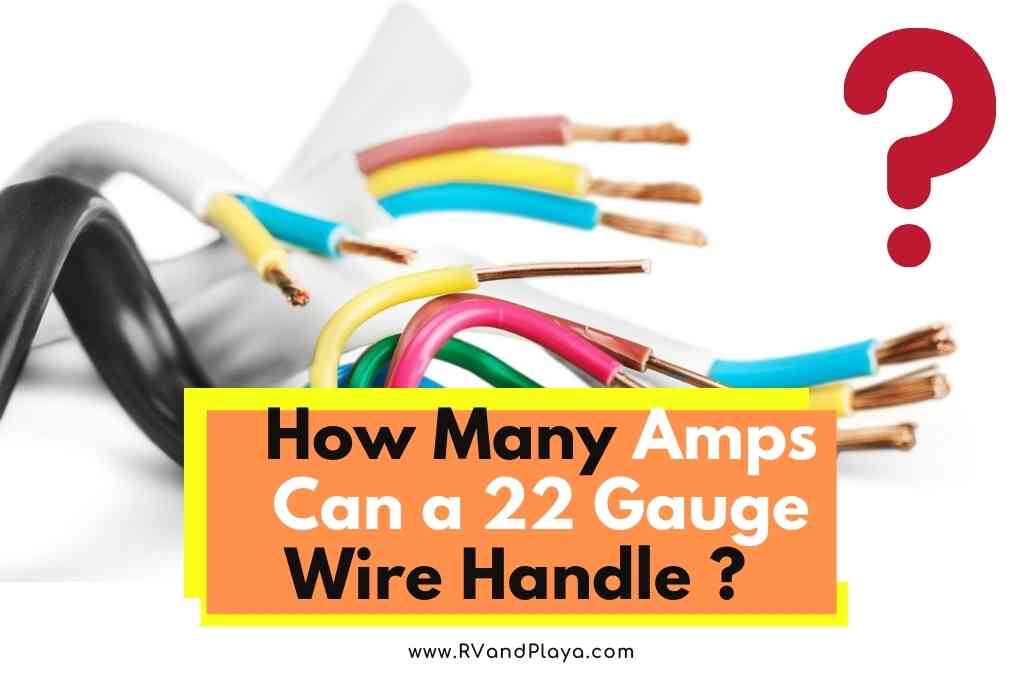Jeff, do you know how many amps a 22 gauge wire can handle? This is one of the questions our readers ask a lot. Well, we´ve got you covered.
While size 22 wire isn’t the smallest of wires on the AWG (American Wire Gauge) table, it is quite a small wire, though it’s useful in and for many, different applications.
If you’re running your own wiring for a particular task, these small wires may be a bit confusing as to how many amps they can pull.
So, how many amps can a 22 gauge wire handle? As far as AWG is concerned, a size 22 wire can safely handle 7 amps at a 75°C temperature rating. However, in standard scenarios, a size 22 wire will only handle .92 amps, which is a whole lot less than what the higher temperature rating can handle.
The totality of 22AWG wires can run anywhere between .92 and 7 amps. Now, that doesn’t mean that you can’t run more amps through a 22AWG wire.
What it means, is that you can only run between .92 and 7 amps safely and only if you are using the appropriate insulation of the wire’s temperature rating.
Any wire, regardless of size or length, will conduct the amount of current applied to it, however, if the current exceeds the conductor’s capacity, then it will become exceedingly hot, melting the jacket around it and, possibly, the wire itself.
Table of Contents
Is 22AWG Strand or Solid?
While there are wires out there that meet the standard specs for a particular AWG number, they are almost entirely of the much larger gauge wire groups, such as 8-gauge and below.
This is especially true when you get down towards the 2-gauge wires and larger.
You won’t typically see stranded variations in much smaller diameter wires, such as 18 and higher, including 22-gauge wire.
A size 22 wire is going to be a solid core, meaning that it is one, solid strand of copper from one end to the there, and nothing else is interwoven.
There are some smaller wires, such as copper-clad aluminum, that have additional metals along with the primary conductor, however, there are no aluminum wires in the much smaller diameter wires, simply because aluminum isn’t the best conductor in the world, and is a waste on smaller diameters.
Still, you may find that some of the smaller diameter wires have silver or another, a highly conductive metal woven around it.
That doesn’t change the dynamic of the primary, copper core conductor which, in and of itself, is still a solid length of copper.
Uses for 22-Gauge Wire
Despite being pretty limited in its conductive capabilities, you will find 22AWG wire in quite a few applications.
There is a reason for its existence, after all. Mostly, wires with this small of a diameter are used in small devices which, of course, makes the most sense.
- Radio intercoms
- Alarm systems
- Walkie Talkies
- Small, home security cameras
Since 22AWG wire is so small in diameter and very flexible, it can be used in devices that require a very low level of power output or input, such as alarm systems.
If you hear a home alarm system go off, you may assume that there is too much going on there for a 22AWG wire to handle.
However, it’s not the size 22 wire handling the alarm but merely the communications from one device to the next.
For example, the little alarm devices that are placed in windows and doors, that send out a signal whenever the door or window is opened, are the devices that have 22AWG wire in them.
It doesn’t take much for an alarm-tripped door device to send a signal to the main alarm in the house, which in turn, emits a loud, blaring alarm that wakes up half of the neighborhood and is usually caused by the cat bumping the window a little too hard.
It’s the same level of communication that you find in walkie-talkies and intercoms. These devices don’t use nor do they need to use a lot of power.
As small, battery-powered communication devices, 22AWG is the perfect conductor to meet their power requirements and fit into the small, cramped spaces that these little devices require.
Radio intercoms are the same way, operating on similar or dissimilar technology, the power requirements simply aren’t robust enough to require something that needs to conduct more than .92 amps at any given time.
Specs for Standard, Size 22 Wiring
Being such a small wire, the specs are notably lacking, which is to be expected. For instance, no one expects size 22 wire will have the capability of conducting more than 300V and that would be true.
- 300 volts
- 80.6 Ohms impedance
- PVC insulation
- -20°C to 60°C operating temperatures
- Solid copper
- .025 inches in diameter
- .645mm
- Power transmission maximum of 0.92 amps
- Chassis wiring maximum amps of 7
In the grand scheme of things, nothing to write home about. However, there are a lot of applications for size 22 wiring, as mentioned above and there are also a few drawbacks from using it.
One of the greatest drawbacks is length. Because this wire is not very large, the rate of resistance is higher.
806 Ohm impedance is the level of resistance in this conductor and if you stretch it out over quite a distance, that level of resistance grows exponentially.
So you cant use size 22 wire in very lengthy applications, which is another reason that you will find this wire in such small devices that are typically battery-powered.
There’s no reason to have a really long cable that is made up of size 22 wire, as the rate of resistance grows so much and so fast that you will reach the wire’s limit in conductive capability long before you reach whatever you’re running it to.
Read also: How Many Amps Can a 6 Gauge Wire Handle (The Truth!)
Of course, this is an imaginary scenario. It’s not as if anyone is making extension cors with 22-gauge wire. However, it’s here just to illustrate a point.
To be fair, it’s a really tiny wire at .025” in diameter, you can’t expect it to carry much in the way of current. When it comes to size 22 wire, it is typically insulated in a PVC jacket, which is generally rated for a temperature allowance of up to 60°C.
If you were to run more than 7 amps through the size 22 AWG, you would see a temperature spike and if that spike rose above 60°C, the insulative properties of the PVC would begin to break down as it melted into a pool below the wire.
It’s possible that you could run enough current through it that the wire would essentially self-destruct, reaching the melting point of copper and turning into a pool of molten metal.
You would have to run quite a bit of current through it though since the melting point of copper is 660°C.
But, that’s why these ratings are applied to the different wire gauges. It’s not the metal that anyone is worried about so much as the potential it will have to harm others, either through fires or direct contact with exposed metal.
Final Thoughts
The amps that a size 22 wire can conduct will run anywhere between 0.92 and 7, depending on the application, length, and insulative properties around the copper wire within.
Size 22 wire is used in several applications, but primarily in portable communication devices and home alarm systems.
Here are some of my favorite tools & equipment´s
Thank you for reading this article. I hope it helps you find the most recent and accurate technical and repair information for your car. Here are some tools that I use as an automotive technician and hope you´ll also find helpful.
There are affiliate links, so if you do decide to use any of them, I´ll earn a small commission. But in all honesty, these are the exact tools that I use and recommend to everyone, even my own family. (NO CRAP)
To see all my of most up-to-date recommendations, check out this resource that I made for you!
References
https://learnmetrics.com/wire-gauge-chart-amp-wire-sizes/
Recent Posts
Have you ever asked yourself or your friend how many Amps a 18 gauge wire can handle? Well, you are at the perfect place to find the answer to such a question. When it comes to low power...
When it comes to the gauge (thickness) of copper wire—or aluminum—the allowable current flow is debatable between what is safe and falls within code, and what it can carry. For safety...


